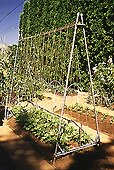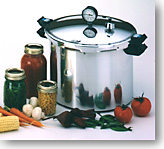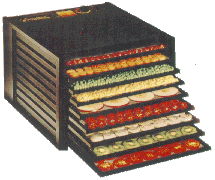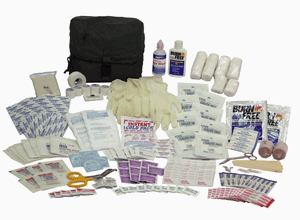HOW I PUT TOGETHER MY
FOOD STORAGE
(A personal history)

"Prepare ye, Prepare ye for that which is to come, for the Lord is nigh" D&C 1:12.
I have a successful food storage. It wasn't easy to get everything on my
budget and it took a while to get it all put together. I would like to share with you my
experience so you can get some ideas on how to put your food storage together and to give
you an idea of what I went through.

When I met my wife just over 13 years ago we discovered we had many things in common. Both
of us had been raised with old fashioned values, you know the old pre-W.W.II type where
mom stayed home, was a homemaker and dad went out and made the cash money. We had been
brought up in homes where food production, preservation and storage were part of living.
Right from the very beginning of our marriage we started emulating what we had been
taught: bulk buying where possible, a small garden, some food preservation, and filling
the cupboards with cans and other food stuffs. We immediately realized the money savings
from having a common food storage interest. And we realized the security gained by knowing
we had resources to fall back on. We also found that it is really helpful if husband and
wife are both interested in doing a food storage. With out each other's help I am sure our
food storage would have been a failure.

For the first 10 months of our marriage we rented a home but we were already becoming
active in gardening and food storage. Then we got a mortgage for our first home we moved
several cases of canned food we had accumulated from the rented home. The new home was on
.21 of an acre and had a 50' X 100' spot that was just perfect for gardening. I was given
a broken rotary tiller and was able to repair it for a reasonable cost. Money was tight so
in this home we would get very serious about food production and preservation.
My wife purchased a steam canner and a steam juicer. The home already had a mature grape
vine and she planned to juice the harvest. Many of the neighbors with fruit trees
were more than happy to let us pick their fruit. The steam canner was for canning the
tomatoes we had planted, salsa and the neighbors fruit. She looked in thrift stores for
canning jars and other canning items.
It wasn't long until we had several dozen cases of canning jars and other canning items.
We prayed over our garden and were blessed every year with a huge harvest. Bushels of
tomatoes, squash, cucumbers, peppers, other veggies, herbs and spices. It didn't matter
how many canning jars we added to our storage my wife was always able to fill all of them
up. Eventually we were given a used pressure canner, after making necessary repairs we
started canning other veggies and meats. At the same time we were frequenting discount
food stores and getting great buys on canned food and produce that we could put up.

We would spend time every summer day out in the garden. We both would pitch in when there
was work to be done. When our first child was old enough he was also helping out where he
could. Gardening and food production are a much better family activity than watching TV.

In our three bedroom home there wasn't much room for food storage but we thought it so
important that we gave one of the basement bedrooms to food storage. The principles of
thrift we were practicing through food production and food storage made it possible for
many years to live on my income alone and we were able to delay the effects of inflation.
Eventually inflation began to aggressively eat away at our budget. We were feeling the
pinch of approximately 300% inflation. Over a ten year period milk had gone from $0.99 a
gallon to almost $3 a gallon. Bread went from $0.25 a loaf to $1. Our phone bill ten yeas
ago was $15 and had gone up to $35 and our house taxes from $350 per year to $1,100 per
year. During the same time I had realized only about a 25% increase in my wage.
Out of necessity we started making all of our own bread, cooking dry beans, making
everything from scratch. To do this we started purchasing 50 pound bags of whole wheat,
beans, peas, quick oats, farina (cream of wheat). Later we purchased 50 pound bags of
salt, sugar, baking soda, corn starch, and other items. By buying in bulk we cut our food
costs to less than half.
We found the best storage container for these products were 6 gallon plastic buckets. We
also purchased a food dehydrator, and put up buckets of dehydrated foods and herbs.

Seeing the American Dream evaporate before our eyes because of inflation
and not wanting to send my wife to work to offset the effective loss of my buying power,
we sold our home. Fortunately we had some equity and was able to purchase with cash a home
150 miles away from the city in a little town. Now without a home payment we had our
outgoing finances down again. I began to wonder, if inflation were to keep eating
away at everyone's buying power eventually there would be an economic crisis. This is when
our food storage graduated from a cost effective way of living to a preparedness hedge
against future bad times.

We began to add survival items to our food storage, water storage, we purchased water
barrels to store water just in case we needed it. We also found 2 liter bottles very good
for storing water. Never use old bleach bottles or milk jugs, they fall apart and allow
smells to enter the water.

Alternative fuel, candles, matches, batteries, lanterns, wood, coal, and a karosene heater
were added.

Medical supplies, extra clothing, personal hygiene items, canning supplies, and some spare
cash were also added. There were other items we added but you get the picture. Now we are
rotating our storage by continuously living out of our food storage and purchasing new to
replace the old.
We don't purchase MRE's or other expensive food storage items, we simply can't afford
them. Besides eating food in its natural form from our food storage is healthy and gets us
used to eating these items. If your family only eats convenience foods you will find whole
wheat makes you sick when you first eat it in large amounts. It usually takes 3 to 6
months to get your body used to eating whole wheat. And unless you are able to find canned
chicken nuggets, canned pizza or afford other fancy canned items then I would suggest you
reevaluate your current eating and food storage habits.
I feel satisfied that we will be able to rely on our food storage in bad times. We have learned how to prepare and eat food storage items and we have been able to preserve our old fashioned values. I hope that our story of food storage is helpful for you.
If you have any questions feel free to e-mail me: Darren Perkins ![]()